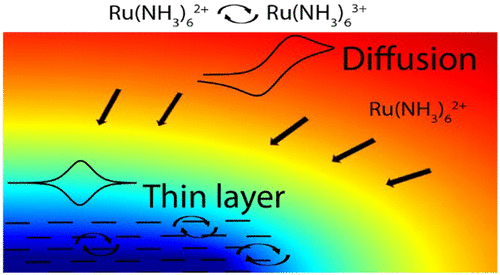Our official English website, www.x-mol.net, welcomes your feedback! (Note: you will need to create a separate account there.)
Influence of Geometry on Thin Layer and Diffusion Processes at Carbon Electrodes
Langmuir ( IF 3.9 ) Pub Date : 2021-02-16 , DOI: 10.1021/acs.langmuir.0c03315 Qun Cao 1 , Zijun Shao 1 , Dale K Hensley 2 , Nickolay V Lavrik 2 , B Jill Venton 1
Langmuir ( IF 3.9 ) Pub Date : 2021-02-16 , DOI: 10.1021/acs.langmuir.0c03315 Qun Cao 1 , Zijun Shao 1 , Dale K Hensley 2 , Nickolay V Lavrik 2 , B Jill Venton 1
Affiliation

|
The geometric structure of carbon electrodes affects their electrochemical behavior, and large-scale surface roughness leads to thin layer electrochemistry when analyte is trapped in pores. However, the current response is always a mixture of both thin layer and diffusion processes. Here, we systematically explore the effects of thin layer electrochemistry and diffusion at carbon fiber (CF), carbon nanospike (CNS), and carbon nanotube yarn (CNTY) electrodes. The cyclic voltammetry (CV) response to the surface-insensitive redox couple Ru(NH3)63+/2+ is tested, so the geometric structure is the only factor. At CFs, the reaction is diffusion-controlled because the surface is smooth. CNTY electrodes have gaps between nanotubes that are about 10 μm deep, comparable with the diffusion layer thickness. CNTY electrodes show clear thin layer behavior due to trapping effects, with more symmetrical peaks and ΔEp closer to zero. CNS electrodes have submicrometer scale roughness, so their CV shape is mostly due to diffusion, not thin layer effects. However, even the 10% contribution of thin layer behavior reduces the peak separation by 30 mV, indicating ΔEp is influenced not only by electron transfer kinetics but also by surface geometry. A new simulation model is developed to quantitate the thin layer and diffusion contributions that explains the CV shape and peak separation for CNS and CNTY electrodes, providing insight on the impact of scan rate and surface structure size. Thus, this study provides key understanding of thin layer and diffusion processes at different surface structures and will enable rational design of electrodes with thin layer electrochemistry.
中文翻译:

几何形状对碳电极薄层和扩散过程的影响
碳电极的几何结构影响其电化学行为,当分析物被困在孔隙中时,大尺度的表面粗糙度会导致薄层电化学。然而,电流响应始终是薄层和扩散过程的混合。在这里,我们系统地探索了薄层电化学和扩散在碳纤维 (CF)、碳纳米钉 (CNS) 和碳纳米管纱线 (CNTY) 电极上的影响。对表面不敏感的氧化还原对 Ru(NH 3 ) 6 3+/2+的循环伏安法 (CV) 响应是经过测试的,所以几何结构是唯一的因素。在 CF 处,由于表面是光滑的,因此反应受扩散控制。CNTY 电极在纳米管之间有大约 10 微米深的间隙,与扩散层厚度相当。由于捕获效应,CNTY 电极显示出清晰的薄层行为,具有更对称的峰和更接近于零的ΔE p 。CNS 电极具有亚微米级粗糙度,因此它们的 CV 形状主要是由于扩散,而不是薄层效应。然而,即使薄层行为的 10% 贡献也将峰分离减少了 30 mV,表明 Δ E p不仅受电子转移动力学的影响,还受表面几何形状的影响。开发了一种新的模拟模型来量化薄层和扩散贡献,从而解释 CNS 和 CNTY 电极的 CV 形状和峰分离,从而深入了解扫描速率和表面结构尺寸的影响。因此,这项研究提供了对不同表面结构的薄层和扩散过程的关键理解,并将能够合理设计具有薄层电化学的电极。
更新日期:2021-03-02
中文翻译:

几何形状对碳电极薄层和扩散过程的影响
碳电极的几何结构影响其电化学行为,当分析物被困在孔隙中时,大尺度的表面粗糙度会导致薄层电化学。然而,电流响应始终是薄层和扩散过程的混合。在这里,我们系统地探索了薄层电化学和扩散在碳纤维 (CF)、碳纳米钉 (CNS) 和碳纳米管纱线 (CNTY) 电极上的影响。对表面不敏感的氧化还原对 Ru(NH 3 ) 6 3+/2+的循环伏安法 (CV) 响应是经过测试的,所以几何结构是唯一的因素。在 CF 处,由于表面是光滑的,因此反应受扩散控制。CNTY 电极在纳米管之间有大约 10 微米深的间隙,与扩散层厚度相当。由于捕获效应,CNTY 电极显示出清晰的薄层行为,具有更对称的峰和更接近于零的ΔE p 。CNS 电极具有亚微米级粗糙度,因此它们的 CV 形状主要是由于扩散,而不是薄层效应。然而,即使薄层行为的 10% 贡献也将峰分离减少了 30 mV,表明 Δ E p不仅受电子转移动力学的影响,还受表面几何形状的影响。开发了一种新的模拟模型来量化薄层和扩散贡献,从而解释 CNS 和 CNTY 电极的 CV 形状和峰分离,从而深入了解扫描速率和表面结构尺寸的影响。因此,这项研究提供了对不同表面结构的薄层和扩散过程的关键理解,并将能够合理设计具有薄层电化学的电极。


























 京公网安备 11010802027423号
京公网安备 11010802027423号